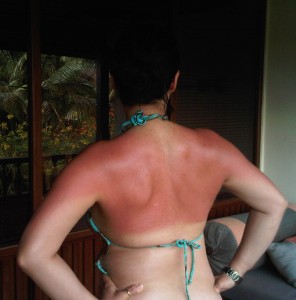 When you are in your mid-thirties and you are like me, still battling or again battling pimples and break-outs, you are in good company. One in five women between the ages of 25 and 40 suffers from adult acne. Adult acne is not different from teenage acne in that the same key factors are involved: Hormonal activity which has an effect on our oil glands, blocked pores, acne bacteria and inflammation. While teenage acne is the result of hormonal changes as a person enters puberty, adult acne is the result of sometimes unexpected hormonal fluctuation, for example due to stress, reaction to birth control, pregnancy, etc.
When you are in your mid-thirties and you are like me, still battling or again battling pimples and break-outs, you are in good company. One in five women between the ages of 25 and 40 suffers from adult acne. Adult acne is not different from teenage acne in that the same key factors are involved: Hormonal activity which has an effect on our oil glands, blocked pores, acne bacteria and inflammation. While teenage acne is the result of hormonal changes as a person enters puberty, adult acne is the result of sometimes unexpected hormonal fluctuation, for example due to stress, reaction to birth control, pregnancy, etc.
What makes adult acne tricky is that the skin of a person in his/ her 30s or 40s is different from teenage skin. Some adults may not even have really oily skin, their skin might be more sensitive, and they may also be very concerned about fighting aging in their skin.
So while we certainly know how to fight blemishes with over-the-counter acne products we get at the drugstore (medicated cleansers, purifying masks, salicylic acid creams, benzoyl peroxide spot treatments, etc.) the challenge with adult acne is how to most effectively treat the blemishes while respecting more mature skin, and just as important, help it look and feel young.
Here are some tips how to approach adult acne with a skincare program.
First of all: If you have persistent pimples or inflamed cysts, you should see a dermatologist as soon as possible to avoid scarring and further damage to the skin. Severe acne is a medical condition that needs to be treated with prescription ingredients like retinoic acid (e.g. Retin-A, Tazorac). For blemish-prone skin and occasional break-outs, a good skincare program and over-the-counter products usually bring significant improvement:
Cleansers: Keep it simple and gentle
Contrary to a stubborn myth, acne is NOT caused by dirty skin, so stay away from harsh cleansers. Also, if your skin is dry and sensitive, skip the medicated cleanser and stick with a simple, gentle, sulfate-free cleanser that will cleanse thoroughly but won’t strip. No matter how convincingly medicated acne cleansers promise not to dry out your skin, I find that they do and that the subsequent dehydration exacerbates the appearance of roughness, lines and wrinkles.
Exfoliate in moderation
Freeing skin of dead skin cells that can clog pores is crucial in preventing blemishes from forming. Gentleness and moderation are key. Exfoliate no more than 2-3 times a week. If you have sensitive skin, no more than once a week. Choose scrubs with perfectly round exfoliating beads or alternatively, if your skin is not overly sensitive, alpha-hydroxy or beta-hydroxy peels. However, if your issue is not occasional blemishes but inflamed acne pimples and lesions, stay away from scrubs altogether. Scrubs can further exacerbate the inflammation of the skin and spread the bacteria.
Hydrate without oil
It’s tempting to not moisturize when you see pimples, but it’s important to keep skin hydrated, no matter what your skin type, even if you have break-outs. If you are concerned about clogging pores, choose an oil-free moisturizer that hydrates with hyaluronic acid. This wonder-ingredient draws vital hydration to the skin without overwhelming with oil, plumping lines and making skin supple.
Spot treat – in more ways than one
Salicylic acid and benzoyl peroxide are proven pimple-fighters, so use them for targeted spot treatments on clean skin before you put on moisturizer or sunscreen. At the same time, do spot-treat age-prone areas or dry areas unaffected by pimples, with products that are more emollient or more concentrated. Examples are the eye area, the area around the lips, forehead, etc. This way, you can effectively combine your acne treatment and anti-aging treatment.
Protect from the sun
A tan may make pimples look less prominent, but there is actually no clinical evidence that sun exposure helps acne. Unprotected sun exposure does raise the risk of skin cancer and premature aging the sun damages. Plus, many acne treatments make skin more sensitive to sun light. Therefore, apply a sunscreen of at least SPF15 daily that is oil-free and light in texture.
Green tea extract – a super multi-tasker?
While green tea extract has been clinically proven to have great anti-aging, antioxidant and anti-inflammatory benefits, recent research suggests that it also has anti-bacterial properties comparable to benzoyl peroxide without the common side effects. While more research needs to be done to prove this effect, this is still promising news for people with sensitive skin and adult acne.
High-tech gadgets
For high-tech lovers, a few electronic devices have popped up on the market that promise to quickly clear up pimples, such as Zeno’s Pro Acne Clearing Device ($185), a battery-powered medical device to treat inflamed acne pimples. It delivers a targeted dose of heat to the acne pimple, which kills the bacteria and is said to significantly clear the pimple within 24 hours. Sounds like the perfect solution!
At the end of the day, there is no one magic bullet for adult acne, but rather, a multi-pronged approach involving gentle and multi-tasking products, targeted medicated treatments and a balanced life-style.
What is your secret to fighting break-outs? Let us know!

